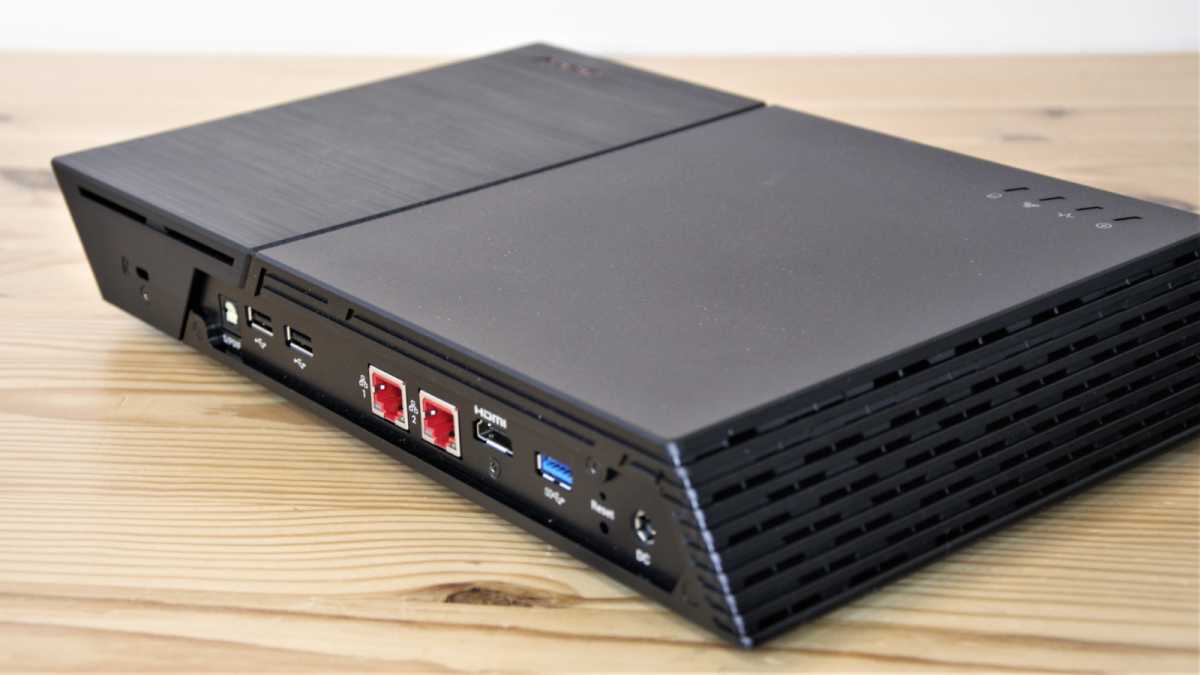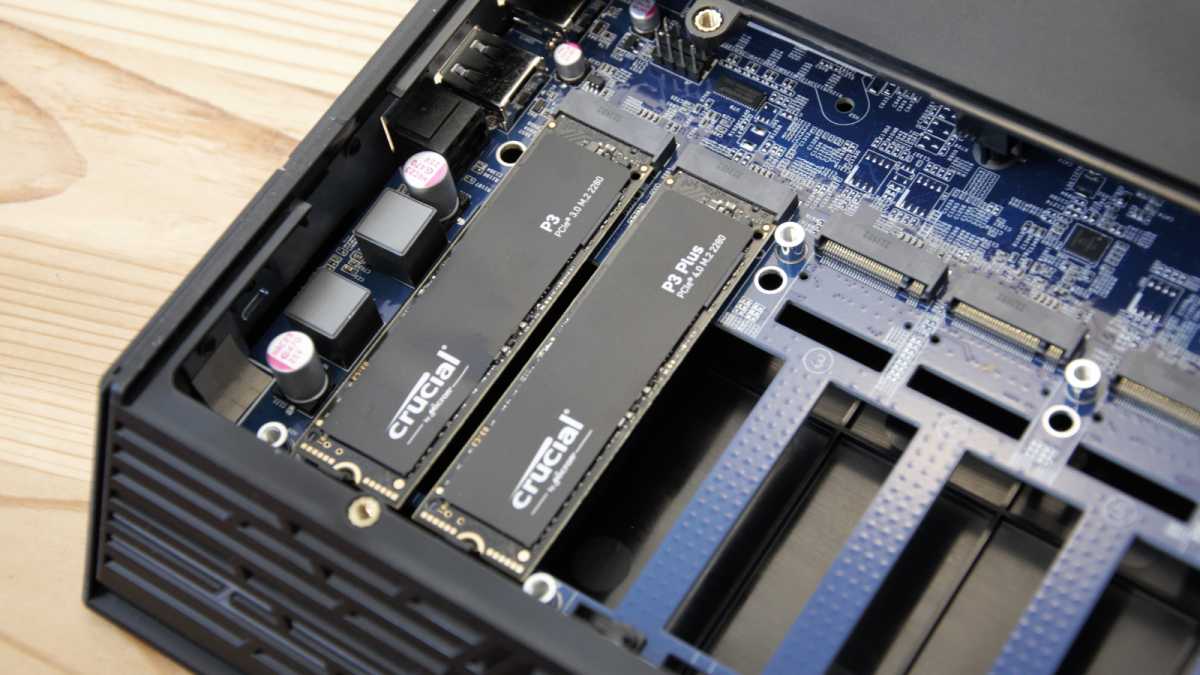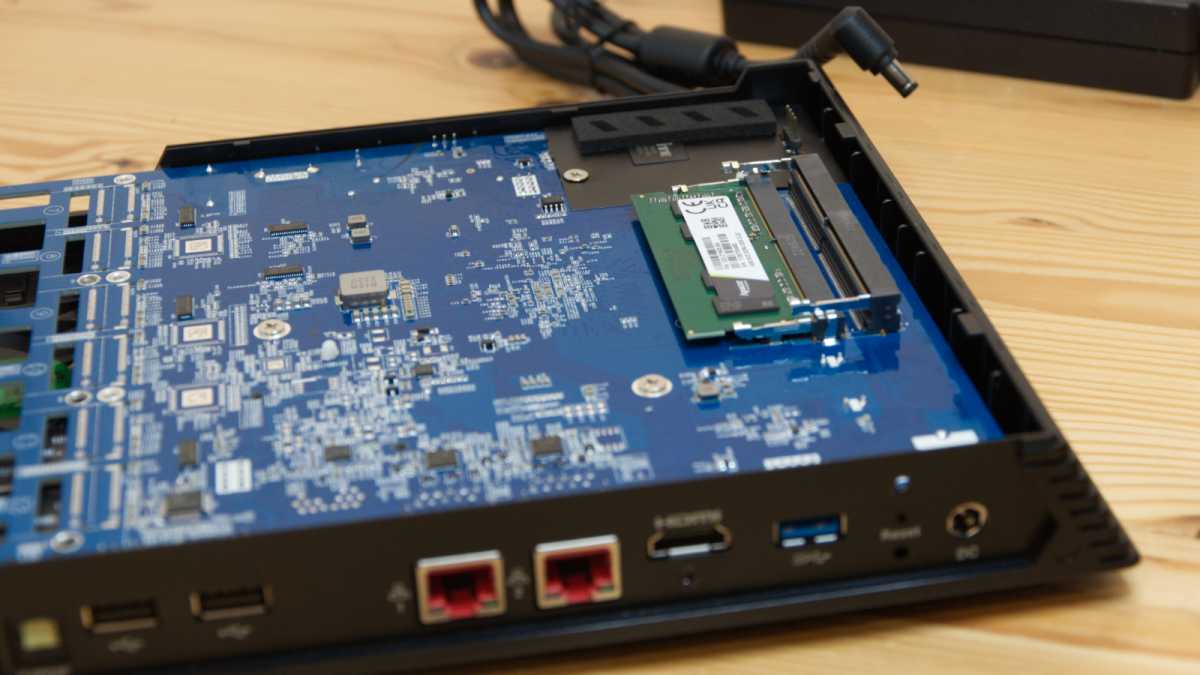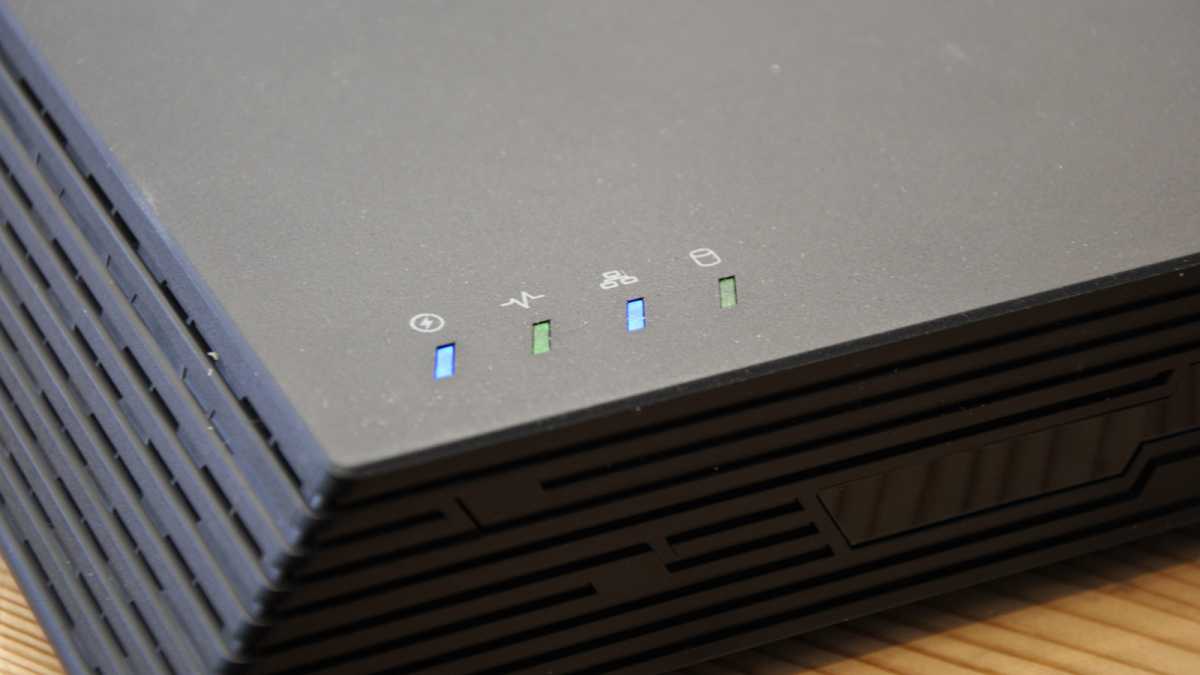
 Image: Mark Pickavance
Image: Mark Pickavance
At a glance
Expert’s Rating
Pros
6 NVMe drive slotsDual 2.5GbE LAN portRAM ExpandableSMB Multichannel
Cons
We need more bandwidthOddly shaped enclosureNo M.2 2230 supports
Our Verdict
A very easy-to-configure and use NAS from Asustor, made practical by the recent drops in NVMe drives. If those price drops continue and NVMe drives get bigger, this could soon be one of the best NAS drives to own.
Price When Reviewed
$479
Best Prices Today: Asustor Flashstor 6 FS6706T
RetailerPrice

Have you noticed the dramatic drop in the price of flash drives recently? Drives and capacities that once cost a significant amount are now highly affordable, and there seems little to arrest the price drops as the spot cost of NAND flash.
The reason is that new wafer densities are coming delivering greater capacities, and that’s pushing down the value of existing wafers in the sales channel.
An interesting impact of the price reduction is that M.2 NVMe drives that were once almost exclusively for desktop PC and server caching use are being utilized purely for their storage capacities.
Up to this point, we’ve seen NAS boxes that use conventional hard drives and SATA SSDs for storage, but if they do accept NVMe drives, it’s typically for caching conventional drives.
Proof we’ve reached a tipping point with the use of these modules comes with two new products from Asustor. The Asustor Flashstor 12 Pro FS6712X and the Flashstor 6 FS6706T, which I’ll be covering in this review.
Essentially, these are the same machine with the exception that the FS6712X can take 12 M.2 NVMe drives and the FS6706T six. And the bigger Flashstor has a single 10GbE LAN port, whereas the six-drive FS6706T has dual 2.5GbE ports.
In all other respects, like processor, memory and expandability, these are brothers from the same mother. The obvious question here is what installing NVMe drives in a NAS can achieve, and is it anything you might want?
Design & Build
Given how small NVMe drives are, Asustor let its engineers go a little wild with the FS67 series, and they came up with this oddly angled box made entirely of dust-attracting black plastic.
This design won’t mount to a rack, but it might not look out of place next to an Xbox or PS5, should you have either of those games consoles.
What slightly mystified me initially is that the power button is hidden under the side with an overhang. When powered, it lights up that side of the NAS, although anyone above or to the left won’t see these visuals due to the angle.

Mark Pickavance
Mark Pickavance
Mark Pickavance
The front facia is mostly for styling apart from a single USB 3.2 Gen 2 port. All the other ports that include more USB, LAN, S/PDIF optical out and HDMI are all on the back.
Access to the storage bay is through an access panel on the underside to the right, and four screws release that to reveal four M.2 NVMe slots.
These are made specifically for 2280 form factor modules, and holes have been cut in the board to allow maximum airflow around them. The only problem here is that the size of those ventilation holes makes using 2230 modules a challenge without an adapter, and this is likely to become a more popular form factor in the future.
Booting this NAS requires a minimum of one NVMe drive, and in my testing, I used two Crucial P3 series modules.
If you want to see the other side of this motherboard, two screws can be removed from the rear, releasing the top. It comes away to reveal two SoDIMM RAM slots, with one occupied with a 4GB DDR4-2933 module.
The maximum amount of RAM that the Intel Celeron N5105 can address is 16GB. This chip does support dual channel mode, so you could add another 4GB to the pre-installed module, or you could take that out and put two 8GB sticks. It might also be possible to put an 8GB module in and get 12GB total in single-channel mode, but I didn’t test that possibility.
Curiously, the bigger FS6712X model comes with the same amount of RAM, hinting that with the speed of the NVMe storage, having extra memory doesn’t impact file-serving performance dramatically.
It’s nice to have options, and for those that like to load up on applications, 16GB offers plenty of working space.
With an NVMe module installed and all the panels back in place, the FS6706T is no different from any other Asustor NAS. Once powered up, the Asustor control centre application can be used to install ADM 4.2 operating system and prepare the NAS for service.
Specs & Features
A quick look around online retailers reveals that the largest NVMe drives are generally available at 8TB. These include the Sabrent Rocket 4 Plus and Corsair MP600 Pro (and Pro XT).
More makers will be creating larger drives since SK Hynix has started producing its new 238-layer 3D NAND wafers to compete with both YMTC and Micron 232-layer chips that will soon be released.
Using any of these, the FS6706T has the potential for 48TB of total capacity and 40TB in a RAID 5 resilient pack.
For home users, 2.5GbE provides a significant bump up from gigabit Ethernet and is rapidly becoming the de facto standard for home and SOHO users.

Mark Pickavance
Mark Pickavance
Mark Pickavance
The ADM operating allows the dynamic expansion of a volume, so it would be possible to start small, with a single 1TB drive, and then expand with subsequent installations. Though if you want to use RAID 5, I’d recommend you start with at least three drives of the same capacity.
Network specifications for this unit are dual 2.5GbE LAN ports, something that most PC motherboards are now coming with as standard. With two 2.5GbE ports, this hardware could be used as a firewall, or those lines can be bonded together for more network bandwidth with a suitable 2.5GbE switch. These ports will automatically downgrade to 1GbE or even 100Mbit if the network infrastructure doesn’t support the full speed.
One potential network configuration is that you plug your computer directly into one of the ports and the other into the network. That gives you the full uninterrupted bandwidth to upload files to the NAS, but also for others to access the contents from the network.
Even combined, two 2.5GbE don’t add up to the bandwidth of the single 10GbE that the FS6712X gets, but realistically 2.5GbE switches are much more affordable than 10GbE ones. For home users, 2.5GbE provides a significant bump up from gigabit Ethernet and is rapidly becoming the de facto standard for home and SOHO users.
There are some possibilities of increasing the network bandwidth further by repurposing the USB 3.2 Gen 2 ports with 2.5GbE or even 5GbE adapters, but the economics of that would suggest that buying the FS6712X would be a better option.
The USB 2.0 ports on this NAS are primarily there for anyone that wants to use it as a computer. It is entirely possible to connect a screen via HDMI, mouse, keyboard, and then install office applications or use web-based office tools.
They can also be used to connect printers and other low-bandwidth peripherals to be accessed over the network.
While some NAS makers include HDMI but don’t make much use of it, Asustor has a graphical interface for HDMI that allows it to be a simple menu solution for Plex, streaming services or links to the web interface.

Mark Pickavance
Mark Pickavance
Mark Pickavance
This functionality, although basic, makes this NAS ideal for media presentations, and the inclusion of a S/PDIF optical output is a useful feature for those wanting to use the FS6706T as a media server with audio being redirected to a Dolby sound system.
There is one final feature of this design I’d like to call out for being incredibly thoughtful, and that’s a strap Asustor included that holds the power cord in place. With this attached, it’s impossible to accidentally pull the power cable from the PSU out of the back of the NAS, which could corrupt the drives if they’re writing data at the time.
I only wish more NAS makers thought about the silly things users can do and how they might be avoided.
The missed opportunity here is that there is plenty of space inside this case for a couple of SATA 2.5in bays, and that might have made this hardware a perfect stepping stone between the world of conventional drives and NVMe.
Being able to cheaply mix a couple of 4TB 2.5in HDDs with four 1TB NVMe modules would have provided much the same network speeds but with greater capacity for less outlay.
Performance
Forget the NVMe drives and how fast they can be. The critical factor in the speed of the FS6706T is the dual 2.5GbE LAN ports for most scenarios.
Because unless the application being used on the Flashstor is working on data stored on the device, exactly how much can come and go is dictated by the LAN ports and how they talk to the clients across the network.
Typically, a single client on a 2.5GbE Ethernet port can shift at least 250Mbps transfer from the NAS, assuming they are the only ones connecting. By using a switch with channel bonding support, the bandwidth can be split between two clients, one on each port.
But, the FS6706T includes beta support for SMB Multichannel, allowing a single client to get all the bandwidth if they’re connected with two 2.5GbE ports or a single 5GbE/10GbE line. The quoted speed for that scenario is 590MB/s reads, and 583MB/s writes, or slightly better than a locally connected SATA SSD.
Over a single 2.5GbE port, we managed 275MB/s reading and writing, more than double that we’d expect from gigabit Ethernet.
Over a single 2.5GbE port, I managed 275MB/s reading and writing, more than double what I’d expect from gigabit Ethernet.
In theory, the USB 3.2 Gen 2 ports could be used with 2.5GbE adapters attached, doubling throughput to the same level as the single 10GbE line on the Flashstor 12. However, we didn’t have those devices to test compatibility with ADM 4.2 or if these could implement SMB Multichannel.
There are a few USB to 5GbE adapters available, but the cost of these devices makes the economic justification for the Flashstor 12 to get a 10GbE LAN connection.

Mark Pickavance
Mark Pickavance
Mark Pickavance
For those doing local NAS processing, it is worth noting that the NVMe drives won’t be operating at full speed. The Intel Celeron N5105 only has eight PCIe lanes, and some are taken up with USB and LAN ports. The limited available lanes would infer that, at best, a single PCIe 3.0 lane is allocated to each NVMe drive.
This lane distribution is a better scenario in the Flashstor 6 than the 12, as in that model, there is only a single lane of PCIe 2.0 for each drive, and PCIe lane switches are required to make the most use of the available bandwidth.
Getting the most out of the Flashstor 6 requires at least a 2.5GbE switch, ideally with support for channel bonding or SMB Multichannel, and clients connected by pairs of 2.5GbE LAN ports.
But, the internal performance of the unit won’t be significantly impacted by the speed of the NVMe drives used, as they’ll be operating well below their potential. We’d recommend purchasing those that are both cheap and have a good TBW value over anything exceptionally fast, and it’s utterly pointless putting PCIe Gen 4 drives in there.
Price & Availability
The Asustor Flashstor 6 FS6706T has a price of $479/£449 on Amazon and Amazon UK. That’s for a unit with 4GB of RAM pre-installed but no NVMe modules.
Its bigger brother, the Asustor Flashstor 12 Pro FS6712X, has an MSRP of $799/£789, but is typically selling for around $825 with the same amount of RAM pre-installed. European pricing roughly equates US dollars to Euros in most countries.
Considering a typical starting installation, say three 2TB NVMe drive to give 4TB of space with a single parity drive for resilience can cost as little as $85/£65 a drive or around $250/£200 for the three. That makes a fully 2TB populated FS6706T close to $1,000/£1,000 for a NAS with 10TB of usable space.
That compares badly with conventional hard drives, but NVMe drives will get larger and cheaper.
Only QNAP and Asustor have gone all-in with NVMe NAS at this point.
QNAP has an NVMe NAS, but the TBS-464 has only four NVMe slots. It also comes with 8GB of RAM and dual 2.5GbE LAN ports, selling for around $599/£625. This unit also can be upgraded via a PCIe card to 10GbE networking.
Those expecting competition from Synology should consider that that company generally only supports its own M.2 branded drives in those NAS that can take them.
Synology NVMe drives have a maximum capacity of 800GB and are exclusively meant for caching. An 800GB Synology M.2 SNV3400 costs an eye-watering $350/£300 and has an underwhelming TBW of 1022TB. Therefore, unless Synology makes a reversal in product strategy, it won’t be releasing an NVMe NAS.
Verdict
My initial reaction to the FS6706T and its FS6712X brother, these products didn’t make a huge amount of sense. Because the internal bandwidth of these devices isn’t enough to exploit multiple NVMe drives of any speed, and certainly not the faster varieties.
When you combine that issue with the inability to exploit that internal bandwidth over the network, it’s tempting to wonder what the point of the Flashstor NAS might be?
But in hindsight, that thinking misses the point somewhat because what an NVMe drive represents to a desktop system isn’t what it is to the Flashstor.
In a desktop system, the critical advantage that NVMe offers is performance, but in the Flashstor 6 (and 12) it is merely storage in a convenient package.
With 16TB NVMe modules using a RAID 5 configuration, the FS6706T could have 80TB of resilient space, and the FS6712X double that.

Mark Pickavance
Mark Pickavance
Mark Pickavance
And, as 8TB and 16TB drives appear, the scale of that storage will become significant for those that can afford to fill their Flashstor with modules.
With 16TB NVMe modules using a RAID 5 configuration, the FS6706T could have 80TB of resilient space, and the FS6712X double that.
Filling the FS6712X with 2TB modules would cost close to $1,000/£1,000 and offer 10TB of resilient capacity with a parity drive. That might seem an expensive option Compared to a conventional NAS running hard drives. But a year ago, the cost of modules alone would have been twice as much, and a year from now, it will likely be much less than now.
Going forward, unless NVMe drives stop being a thing, filling up the Flashstor will only get cheaper. And, with the performance it can deliver in this context, it’s much faster to rebuild these packs with new larger modules than it would be with hard drives.
In short, the FS6706T doesn’t have the internal PCIe bandwidth to exploit six NVMe drives fully. And it also can’t push the limited bandwidth it has out over two 2.5GbE ports, but for the purpose of this exercise, that might not matter.
And it won’t until we’re all running NAS with 400GbE or faster networks, should that ever happen.
Specs
CPU: Intel Celeron N5105
GPU: Intel UHD Graphics
RAM: 4GB DDR4 (upgradable to 16GB)
Storage: 6 x M.2 NVMe PCIe 3.0 drives.
USB: 2x USB 3.2 Gen 2, 2x USB 2.0
Outputs: 1x HDMI 2.0 port compatible with 4K 60 Hz resolutions, 1x S/PDIF
Raid Types: RAID 0/1 /5 /6 /10, Single, JBOD
Weight: 3.6 kg
Dimensions: 227 x 225x 136 mm
Networking: 2x 2.5-GbE Ethernet (100/1000/2500)
OS: ADM 4.2
Internal File Systems: Btrfs, EXT4
External File Systems: EXT4, NTFS, FAT32, HFS+, ExFAT
OS Languages: English, German, French, Spanish, Italian, Magyar, Chinese, Japanese, Korean, Turkish, Portuguese and Russian
This review originally appeared on techadvisor.com.
Best Prices Today: Asustor Flashstor 6 FS6706T
RetailerPrice

Author: Mark Pickavance, Contributor

Mark is an expert on displays, reviewing monitors and TVs. He also covers storage including SSDs, NAS drives and portable hard drives. He started writing in 1986 and had contributed to MicroMart, PC Format, 3D World among others.
Recent stories by Mark Pickavance:
Synology DiskStation DS223j review: New NAS, same appealing storyTerraMaster F2-212 review: Entry-level NAS with optionsAsustor Nimbustor 2 Gen2 AS5402T review: The ultimate small NAS



